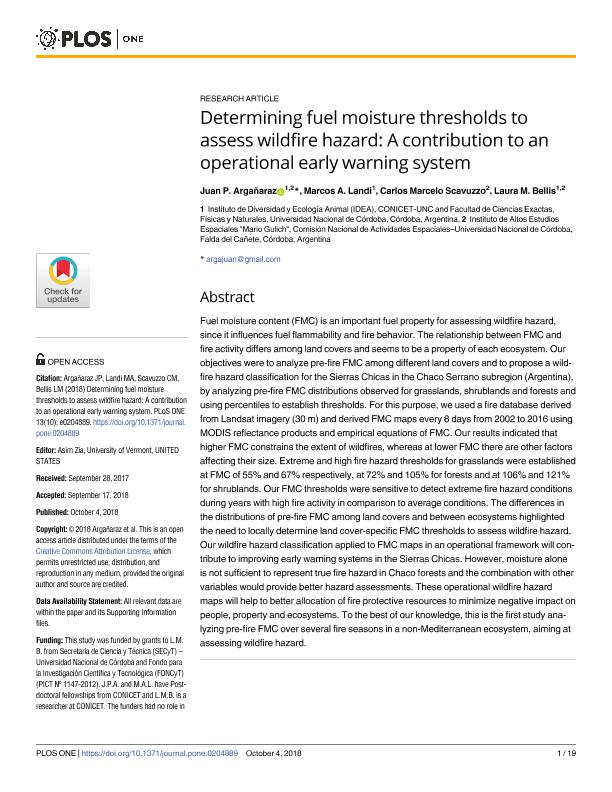Mostrar el registro sencillo del ítem
dc.contributor.author
Argañaraz, Juan Pablo

dc.contributor.author
Landi, Marcos Alejandro

dc.contributor.author
Scavuzzo, Carlos Marcelo

dc.contributor.author
Bellis, Laura Marisa

dc.date.available
2019-10-23T17:54:19Z
dc.date.issued
2018-10-04
dc.identifier.citation
Argañaraz, Juan Pablo; Landi, Marcos Alejandro; Scavuzzo, Carlos Marcelo; Bellis, Laura Marisa; Determining fuel moisture thresholds to assess wildfire hazard: A contribution to an operational early warning system; Public Library of Science; Plos One; 13; 10; 4-10-2018
dc.identifier.uri
http://hdl.handle.net/11336/87101
dc.description.abstract
Fuel moisture content (FMC) is an important fuel property for assessing wildfire hazard, since it influences fuel flammability and fire behavior. The relationship between FMC and fire activity differs among land covers and seems to be a property of each ecosystem. Our objectives were to analyze pre-fire FMC among different land covers and to propose a wildfire hazard classification for the Sierras Chicas in the Chaco Serrano subregion (Argentina), by analyzing pre-fire FMC distributions observed for grasslands, shrublands and forests and using percentiles to establish thresholds. For this purpose, we used a fire database derived from Landsat imagery (30 m) and derived FMC maps every 8 days from 2002 to 2016 using MODIS reflectance products and empirical equations of FMC. Our results indicated that higher FMC constrains the extent of wildfires, whereas at lower FMC there are other factors affecting their size. Extreme and high fire hazard thresholds for grasslands were established at FMC of 55% and 67% respectively, at 72% and 105% for forests and at 106% and 121% for shrublands. Our FMC thresholds were sensitive to detect extreme fire hazard conditions during years with high fire activity in comparison to average conditions. The differences in the distributions of pre-fire FMC among land covers and between ecosystems highlighted the need to locally determine land cover-specific FMC thresholds to assess wildfire hazard. Our wildfire hazard classification applied to FMC maps in an operational framework will contribute to improving early warning systems in the Sierras Chicas. However, moisture alone is not sufficient to represent true fire hazard in Chaco forests and the combination with other variables would provide better hazard assessments. These operational wildfire hazard maps will help to better allocation of fire protective resources to minimize negative impact on people, property and ecosystems. To the best of our knowledge, this is the first study analyzing pre-fire FMC over several fire seasons in a non-Mediterranean ecosystem, aiming at assessing wildfire hazard.
dc.format
application/pdf
dc.language.iso
eng
dc.publisher
Public Library of Science

dc.rights
info:eu-repo/semantics/openAccess
dc.rights.uri
https://creativecommons.org/licenses/by-nc-sa/2.5/ar/
dc.subject
Fuel moisture content
dc.subject
MODIS
dc.subject
Thresholds
dc.subject
Fire hazard
dc.subject.classification
Otras Ciencias de la Tierra y relacionadas con el Medio Ambiente

dc.subject.classification
Ciencias de la Tierra y relacionadas con el Medio Ambiente

dc.subject.classification
CIENCIAS NATURALES Y EXACTAS

dc.title
Determining fuel moisture thresholds to assess wildfire hazard: A contribution to an operational early warning system
dc.type
info:eu-repo/semantics/article
dc.type
info:ar-repo/semantics/artículo
dc.type
info:eu-repo/semantics/publishedVersion
dc.date.updated
2019-10-16T14:26:59Z
dc.identifier.eissn
1932-6203
dc.journal.volume
13
dc.journal.number
10
dc.journal.pais
Estados Unidos

dc.journal.ciudad
San Francisco
dc.description.fil
Fil: Argañaraz, Juan Pablo. Consejo Nacional de Investigaciones Científicas y Técnicas. Centro Científico Tecnológico Conicet - Córdoba. Instituto de Diversidad y Ecología Animal. Universidad Nacional de Córdoba. Facultad de Ciencias Exactas Físicas y Naturales. Instituto de Diversidad y Ecología Animal; Argentina
dc.description.fil
Fil: Landi, Marcos Alejandro. Consejo Nacional de Investigaciones Científicas y Técnicas. Centro Científico Tecnológico Conicet - Córdoba. Instituto de Diversidad y Ecología Animal. Universidad Nacional de Córdoba. Facultad de Ciencias Exactas Físicas y Naturales. Instituto de Diversidad y Ecología Animal; Argentina
dc.description.fil
Fil: Scavuzzo, Carlos Marcelo. Comision Nacional de Actividades Espaciales. Instituto de Altos Estudios Espaciales "Mario Gulich"; Argentina
dc.description.fil
Fil: Bellis, Laura Marisa. Consejo Nacional de Investigaciones Científicas y Técnicas. Centro Científico Tecnológico Conicet - Córdoba. Instituto de Diversidad y Ecología Animal. Universidad Nacional de Córdoba. Facultad de Ciencias Exactas Físicas y Naturales. Instituto de Diversidad y Ecología Animal; Argentina
dc.journal.title
Plos One

dc.relation.alternativeid
info:eu-repo/semantics/altIdentifier/url/https://journals.plos.org/plosone/article/file?id=10.1371/journal.pone.0204889&type=printable
dc.relation.alternativeid
info:eu-repo/semantics/altIdentifier/doi/https://doi.org/10.1371/journal.pone.0204889
Archivos asociados
